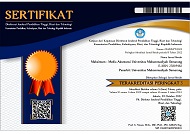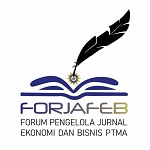The Effect of Liquidity, Leverage, Profitability and Firm size on Financial Distress with GCG as a Moderation Variable
(1) Universitas Muhammadiyah Magelang
(2) Universitas Muhammadiyah Magelang
(3) Universitas Muhammadiyah Semarang
(*) Corresponding Author
Abstract
Financial difficulties will arise due to the company's inability to compete, and when a company's finances are in trouble, these conditions trigger bankruptcy. This study examines the effect of liquidity, leverage, profitability and firm size on financial distress with good corporate governance as a moderation variable. The population of this study is mining companies listed on the Indonesia stock exchange from 2018 to 2021 and using purposive sampling. The data analysis used was moderate regression analysis with the help of the SPSS 24 tool. The results showed that liquidity did not affect financial distress, leverage positively affected financial distress, and profitability and firm size negatively affected financial distress. Good corporate governance weakens the effect of liquidity and profitability on financial distress. Good corporate governance strengthens profitability and financial distress. Good corporate governance does not moderate the relationship between firm size and financial distress.
Keywords
Full Text:
PDFReferences
Agung, G., Hasnawati, S., & Huzaimah, R. A. F. (2021). The Effect Of Investment Decision,Financing Decision, Dividend Policy On Firm Value(Study On Food And Beverage Industry Listed On The Indonesia Stock Exchange, 2016-2018). Jurnal Bisnis Dan Manajemen, 17(1), 1–12. https://doi.org/10.23960/jbm.v17i1.189
Agustin, R., Nurcahyono, N., Sinarasri, A., & Sukesti, F. (2023). Financial Ratio and Stock Returns in Indonesia Equity Markets : A Signaling Theory Approach. International Conference on Business, Accounting, Banking, and Economics, 277–292. https://doi.org/10.2991/978-94-6463-154-8
Ariesanti, D. D. (2015). Pengaruh Mekanisme Good Corporate Governance dan Financial Distress terhadap Manajemen Laba (Studi Kasus pada Perusahaan Perbankan yang Terdaftar di Bursa Efek Indonesia Periode 2009-2014). Jurnal Mahasiswa Universitas Negeri Surabaya, 274–282.
Arini, S. A., Samrotun, Y. C., & Masitoh, E. (2021). Determinant of Financial Ratio Analysis to Financial Distress. Jambura Science of Management, 3(1), 26–35.
Ashraf, S., G. S. Félix, E., & Serrasqueiro, Z. (2019). Do Traditional Financial Distress Prediction Models Predict the Early Warning Signs of Financial Distress? Journal of Risk and Financial Management, 12(2), 55. https://doi.org/10.3390/jrfm12020055
Azalia, V., & Rahayu, Y. (2019). Pengaruh Leverage, Likuiditas, Profitabilitas, Dan Ukuran Perusahaan Terhadap Financial Distress. Jurnal Ilmu Dan Riset Akuntansi, 86–101.
Azzahra, N., Sofianty, D., & Nurcahyono, N. (2023). Pengaruh Kesadaran Wajib Pajak dan Pengetahuan Pajak terhadap Kepatuhan Wajib Pajak Orang Pribadi. Bandung Conference Series: Accountancy, 3(1), 1–13. https://doi.org/10.29313/bcsa.v3i1.5853
Brigham, E. F., & Houston, J. F. (2021). Fundamentals of financial management. Cengage Learning.
Bukhori, I., & Meilani. (2019). Analisis Pengaruh Likuiditas, Aktivitas, Leverage dan Sales Growth terhadap Kondisi Financial Distress ( Studi pada Perusahaan Manufaktur di Bursa Efek Indonesia Tahun 2016-2019 ).
Bursa Efek Indonesia. (n.d.). Laporan Keuangan dan Tahunan 2018-2021. www.idx.co.id
Du, X., Li, W., Ruan, S., & Li, L. (2020). CUS-heterogeneous ensemble-based financial distress prediction for imbalanced dataset with ensemble feature selection. Applied Soft Computing, 97, 106758.
Erayanti, R. (2019). Pengaruh Likuiditas, Profitabilitas dan Leverage terhadap Prediksi Financial Distress. Jurnal Riset Akuntansi & Perpajakan (JRAP), 6(01), 38–51. https://doi.org/10.35838/jrap.v6i01.393
Ermawati, D., Nurcahyono, N., Sari, D. N., & Fakhruddin, I. (2023). The Dynamic Impact of Intellectual Capital on Firm Value : Evidence from Indonesia. International Conference on Business, Accounting, Banking, and Economics, 1, 246–262. https://doi.org/10.2991/978-94-6463-154-8
Fitria, A., & Syahrenny, N. (2022). Pengaruh Profitabilitas, Likuiditas, Leverage, dan Ukuran Perusahaan terhadap Financial Distress. Fair Value: Jurnal Ilmiah Akuntansi Dan Keuangan, 5(1), 45–60. https://doi.org/10.32670/fairvalue.v5i2.2135
Fizabaniyah, R., Nurcahyono, N., Argojuwono, A. D. A., & Hernawati, R. I. (2023). Financial Ratio , Board Diversity and Financial Distress : Evidence from Indonesia. International Conference on Business, Accounting, Banking, and Economics, 1, 307–320. https://doi.org/10.2991/978-94-6463-154-8
Gilang, M. (2019). Analisis Pengaruh Corporate Governance Perception Index, Ukuran Perushaan Dan Leverage Terhadap Financial Distress : Studi Empiris Pada Perusahaan Peserta Cgpi Yang Terdaftar Di Bursa Efek Indonesia Tahun 2012-2016. Diponegoro Journal of Accounting, 8(3), 1–10.
Harahap, S. S. (2018). Teori akuntansi. Raja Grafindo.
Hashed, A. A., & Almaqtari, F. A. (2021). The impact of corporate governance mechanisms and ifrs on earning management in Saudi Arabia. Accounting, 7(1), 207–224. https://doi.org/10.5267/j.ac.2020.9.015
Hutauruk, M. R., Riyanto, A., & Putri, G. U. (2022). The Factors Impact On Earnings Management On Indonesia Mining Company. Jurnal Akuntansi, 26(3), 443–463. https://doi.org/10.24912/ja.v26i3.1067
Jodjana, J. J., Nathaniel, S., Rinaningsih, R., & Pranoto, T. (2021). The Effect of Board and Ownership Structure on the Possibility of Financial Distress. Journal of Accounting and Investment, 22(3), 602–624.
Kasmir. (2018). Analisis Laporan Keuangan (11th ed.). Rajawali Pers.
Khalid, M., Abbas, Q., Malik, F., & Ali, S. (2020). Impact of audit committee attributes on financial distress: Evidence from Pakistan. International Journal of Financial Engineering, 07(01), 2050005. https://doi.org/10.1142/s242478632050005x
Kisman, Z., & Krisandi, D. (2019). How to Predict Financial Distress in the Wholesale Sector: Lesson from Indonesian Stock Exchange. Journal of Economics and Business, 2(3), 569–585. https://doi.org/10.31014/aior.1992.02.03.109
Kosasih, D. T. (2021). Pandemi COVID-19, Pendapatan Tiga Emiten BUMN Tambang Turun pada 2020. Liputan 6.
Kristianingrum, A., Sukesti, F., & Nurcahyono, N. (2022). Pengaruh Mekanisme Good Corporate Governance, Kinerja Keuangan, dan Struktur Modal terhadap Pengungkapan Sustainability Report. Prosiding Seminar Nasional UNIMUS, 5, 432–444.
Kusmawati, K. E., Wayan, S. I., & Suarjana, I. W. (2022). Pengaruh Rasio Likuiditas, Rasio Solvabilitas, Rasio Rentabilitas Rasio Aktivitas dan Ukuran Perusahaan terhadap Financial Distress pada Perusahaan Manufaktur yang Terdaftar di Bursa Efek Indonesia Tahun 2018 – 2020. Jurnal Emas, 3(April).
Kusumayani, N. L., Widanaputra, A. A. G. ., Wirama, D. G., & Budiasih, I. G. A. N. (2019). The Ability of Good Corporate Governance in Moderating the Effects of Financial Distress on the Velocity of Publication of the Financial Statements. International Journal of Multicultural and Multireligious Understanding, 6(5), 80. https://doi.org/10.18415/ijmmu.v6i5.1056
Nilasari, I. (2021). Pengaruh Corporate Governance, Financial Indicators, dan Ukuran Perusahaan terhadap Financial Distress. Competitive Jurnal Akuntansi Dan Keuangan, 5(2), 61–68.
Nurcahyono, N., Hanum, A. N., Kristiana, I., & Pamungkas, I. D. (2021). Predicting fraudulent financial statement risk: The testing dechow f-score financial sector company inindonesia. Universal Journal of Accounting and Finance, 9(6), 1487–1494. https://doi.org/10.13189/ujaf.2021.090625
Nurcahyono, N., Hanum, A. N., & Sinarasri, A. (2023). Does Board Diversity and Financial Ratio Predict the Risk of Financial Distress ?? International Conference on Business, Accounting, Banking, and Economics, April 2020, 337–348. https://doi.org/10.2991/978-94-6463-154-8
Nurcahyono, N., Hanum, A. N., & Sukesti, F. (2021). COVID 19 Outbreak and Stock Market Return: Evidence from Indonesia. Jurnal Dinamika Akuntansi Dan Bisnis, 8(1), 47–58. https://doi.org/10.24815/jdab.v8i1.18934
Oktaviani, M., Rosmaniar, A., & Hadi, S. (2019). Pengaruh Ukuran Perusahaan (Size) Dan Struktur Modal Terhadap Nilai Perusahaan. BALANCE: Economic, Business, Management and Accounting Journal, 16(1). https://doi.org/10.30651/blc.v16i1.2457
Pratiwi, E. Y., & Sudiyatno, B. (2022). Pengaruh likuiditas , leverage , dan profitabilitas terhadap financial distress. 5(3), 1324–1332.
Pratiwi, I., Hanum, A. N., & Nurcahyono, N. (2022). Pengaruh Earning Per Share, Total Assets Turnover, Pertumbuhan Penjualan dan Debt Equity Ratio Terhadap Harga Saham. Jurnal Akuntansi, Perpajakan Dan Portofolio, 02(02), 39–50. https://journal.umpo.ac.id/index.php/JAPP/article/view/5584%0Ahttps://journal.umpo.ac.id/index.php/JAPP/article/download/5584/2405
Putri, P. A. (2021). The Effect of Operating Cash Flows, Sales Growth, and Operating Capacity in Predicting Financial Distress. International Journal of Innovative Science and Research Technology, 6(1), 638–646. www.ijisrt.com638
Rafatnia, A. A., Suresh, A., Ramakrishnan, L., Abdullah, D. F. B., Nodeh, F. M., & Farajnezhad, M. (2020). Financial distress prediction across firms. Journal of Environmental Treatment Techniques, 8(2), 646–651.
Rahma, A. M., Nurcahyono, N., & Sinarasri, A. (2022). Moderating Effects of Institutional Ownership on the Relation Between Capital Structure. International Conference on Business, Accounting, Banking, and Economics, 1, 293–306. https://doi.org/10.2991/978-94-6463-154-8
Sahfasat, V. M., & Nurmala, P. (2022). Pengaruh Arus Kas Investasi, Arus Kas Operasi, dan Market Value Added Terhadap Return Saham. Maksimum: Media Akuntansi Universitas Muhammadiyah Semarang, 12(2), 107. https://doi.org/10.26714/mki.12.2.2022.107-120
Sakinah, F. dkk. (2018). Pengaruh Likuiditas dan Leverage Terhadap Probabilitas Financial Distress Dengan Good Corporate Governance Sebagai Variabel Moderasi. Jom Feb, 1(1), 1–13.
Rama, B. S. (Universitas K. S. W. (2022). Pengaruh Leverage dan Likuiditas terhadap Financial Distress dengan Pemoderasi Good Corporate Governance [Universitas Kristen Satya Wacana]. https://repository.uksw.edu//handle/123456789/27507
Septiani, N. M. I., & Dana, I. M. (2019). Pengaruh Likuiditas, Leverage, Dan Kepemilikan Institusional Terhadap Financial Distress Pada Perusahaan Property Dan Real Estate. E-Jurnal Manajemen Universitas Udayana, 8(5), 3110. https://doi.org/10.24843/ejmunud.2019.v08.i05.p19
Sari, Q. M., & Rohman, A. (2023). Pengaruh Rasio Keuangan Terhadap Financial Distress dengan Good Corporate Governance Sebagai Variabel Moderating. Diponegoro Journal of Accounting, 12(2019), 1–12.
Setyobudi, A., Amboningtyas, D., & Yulianeu. (2017). The Analysis of Liquidity, Leverage, Profitability, and Firm Size Influence Toward The Financial Distress with Good Corporate Governance as the Moderating Variabel in PT. Telekomunikasi Indonesia Tbk and PT. Indosat Tbk. 3, 316–317.
Shayan-nia, M., Sinnadurai, P., Mohd-sanusi, Z., & Hermawan, A. A. (2017). Research in International Business and Finance How e ffi cient ownership structure monitors income manipulation ? Evidence of real earnings management among Malaysian fi rms. Research in International Business and Finance, 41(October 2016), 54–66. https://doi.org/10.1016/j.ribaf.2017.04.013
Sopian, D., & Rahayu, W. P. (2017). Pengaruh Rasio Keuangan dan Ukuran Perusahaan Terhadap Financial Distress (Studi Empiris Pada Perusahaan Food and Beverage di Bursa Efek Indonesia). COMPETITIVE Jurnal Akuntansi Dan Keuangan, 1.
Spence, M. (1973). Signaling Theory: A Review and Assessment. The Quarterly Journal of Economics, 87(3), 355–374.
Timoty, N. F. M., Nurcahyono, N., Yasaputri, K., & Jatiningsih, D. E. S. (2022). Predicting the risk of financial distress using corporate governance measures. International Conference on Business, Accounting, Banking, and Economics, 68, 228–245. https://doi.org/10.1016/j.pacfin.2020.101334
Wahyuni, P. D. (2021). Determinants of Financial Distress Prediction Using Springate Model: Based on GCG and Financial Indicators. South East Asia Journal of Contemporary Business, Economics and Law, 24(2), 120–129.
Younas, N., UdDin, S., Awan, T., & Khan, M. Y. (2021a). Corporate governance and financial distress: Asian emerging market perspective. Corporate Governance: The International Journal of Business in Society.
Younas, N., UdDin, S., Awan, T., & Khan, M. Y. (2021b). Corporate governance and financial distress: Asian emerging market perspective. Corporate Governance (Bingley), 21(4), 702–715. https://doi.org/10.1108/CG-04-2020-0119
Yuliyani, N. M. A., & Erawati, N. M. A. (2017). Pengaruh financial distress, profitabilitas, leverage, dan likuiditas pada opini audit going concern. E-Jurnal Akuntansi, 19(2), 1490–1520.
Article Metrics
Abstract view : 174 timesPDF - 2 times
DOI: https://doi.org/10.26714/mki.12.2.2022.143-153
Refbacks
- There are currently no refbacks.
-----------------------------------------------------------------------------------------------------------------------------------------------------------------------------------
 | MAKSIMUM: Media Akuntansi Universitas Muhammadiyah Semarang |
![]()
Maksimum: Media Akuntansi Universitas Muhammadiyah Semarang is licensed under a Creative Commons Attribution Attribution-NonCommercial-NoDerivatives 4.0 International License.

















